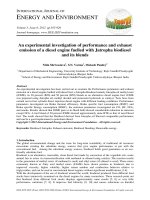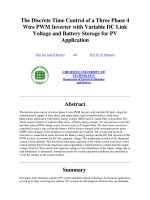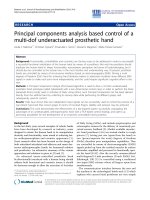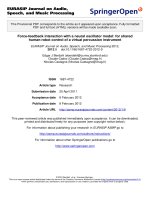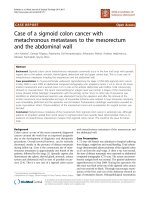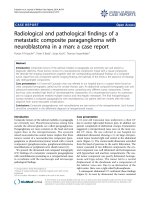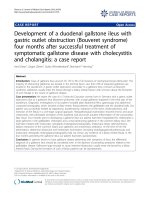Dynamic Modeling and Control of a Flexible Link Manipulators with Translational and Rotational Joints
Bạn đang xem bản rút gọn của tài liệu. Xem và tải ngay bản đầy đủ của tài liệu tại đây (938.78 KB, 8 trang )
<span class='text_page_counter'>(1)</span><div class='page_container' data-page=1>
<b>Dynamic Modeling and Control of a Flexible Link Manipulators with</b>
<b>Translational and Rotational Joints</b>
<i><b>Dương Xuân Biên</b></i>
<i><b>1,*</b></i><i><b><sub>, Chu Anh Mỳ</sub></b></i>
<i><b>1</b></i><i><b><sub>, Phan Bùi Khôi</sub></b></i>
<i><b>2</b></i><i>1<sub> Military Technical Academy, No. 236, Hoang Quoc Viet, Cau Giay, Hanoi, Viet Nam</sub></i>
<i>2<sub>Hanoi University of Science and Technology, No. 1, Dai Co Viet, Hai Ba Trung, Hanoi, Viet Nam</sub></i>
<b>Abstract</b>
<i>Flexible link manipulators are widely used in many areas such the space technology, medical, defense and automation</i>
<i>industries. They are more realistic than their rigid counterparts in many practical conditions. Most of the</i>
<i>investigations have been confined to manipulators with only rotational joint. Combining such systems with</i>
<i>translational joints enables these manipulators more flexibility and more applications. In this paper, a nonlinear</i>
<i>dynamic modeling and control of flexible link manipulator with rigid translational and rotational joints is presented.</i>
<i>Finite element method and Lagrange approach are used to model and build equations of the motion. PID controller is</i>
<i>designed with parameters (Kp, Ki, Kd) which are optimized by using Particle Swarm Optimization algorithm (PSO)</i>
<i>based on fitness function. Errors of joints variables and elastic displacements at the end-effector point are reduced in</i>
<i><b>short time to warrant initial request. The numerical simulation results are calculated by using MATLAB/SIMULINK</b></i>
<i>toolboxes. </i>
<i>Keywords: flexible link, translational joint, elastic displacements, control, PSO. </i>
<b>1. Introduction1</b>
Flexible link manipulators with translational and
rotational joint have received more attention recently
because of many advantages and applications. The
considering translational joint and elastic
displacements effects on robot motion become
complicated because of highly nonlinear
characteristics.
Few authors have studied the manipulator with
only translational joint. Wang and Duo Wei [1]
presented a single flexible robot arm with
translational joint. Dynamic model analysis is based
on a Galerkin approximation with time dependent
basis functions. They also proposed a feedback
control law in [2]. Kwon and Book [3] present a
single link robot which is described and modeled by
using assumed modes method (AMM). Other authors
have focused on the flexible manipulator with a link
slides through a translational joint with a
simultaneous rotational motion (R-T robot). Pan et al
[4] presented a model R-T with FEM method. The
result is differential algebraic equations which are
solved by using Newmark method. Yuh and Young
[5] proposed the partial differential equations with
R-T system by using AMM. Al-Bedoor and Khulief [6]
presented a general dynamic model for R-T robot
based on FEM and Lagrange approach. They defined
a concept which is translational element. The stiffness
of translational element is changed. The translational
joint variable is distance from origin coordinate
1 * Corresponding author: Tel.: (+84)
166.7193.567
Email:
system to translational element. The number of
element is small because it is hard challenge to build
and solve differential equations. Khadem [7] studied
a three-dimensional flexible n-degree of freedom
manipulator having both revolute and translational
joint. A novel approach is presented using the
perturbation method. The dynamic equations are
derived using the Jourdain’s principle and the
Gibbs-Appell notation. Korayem [8] also presented a
systematic algorithm capable of deriving equations of
motion of N-flexible link manipulators with
revolute-translational joints by using recursive Gibbs-Appell
formulation and AMM.
In addition, the order of the translational joints
in the kinematic chain has not been considered in the
reviewed researches. Almost related works
demonstrate their method through the rotational –
translational model (R -T model). This is just a
specific case of the general kinematic chain of the
flexible manipulator.
</div>
<span class='text_page_counter'>(2)</span><div class='page_container' data-page=2>
called particles and the population is known as swarm
[15]. The main strength of PSO is that it is easy to
implement and fast convergent. PSO has become
robust and widely applied in continuous and discrete
optimization for engineering applications.
However, most of the investigations on
intelligent control of the flexible robot manipulator
focus on the robot structure constructed with all
rotational joints.
In this work, dynamic model of flexible link
manipulator combining translational and rotational
joints is presented. This model (T-R) is difference R-T
model. The first link is assumed rigidly which is
attached rigid translational. The second link is
flexibility with rigid rotational joint. The dynamic
model is described in fig. 1. The PID control system is
designed to warrant following reference point and
desire path in joint space based on errors of joint
variables and value of elastic displacement at the
end-effector point. Parameters of PID control are
optimized by using PSO algorithm. Fitness function
is the linear quadratic regulator (LQR) function.
<b>2. Dynamic modeling and equations of motion</b>
<i><b>2.1. Dynamic modeling</b></i>
The model of two link flexible robot which
motions on horizontal plane with translational joint
for first rigid link and rotational joint for second
flexible link is shown as Fig 1.
Fig. 1. Flexible links robot with translational and
rotational joints
The coordinate system <i>XOY</i> is the fixed frame.
Coordinate system <i>X O Y</i>1 1 1<sub> is attached to end point of</sub>
link 1. Coordinate system <i>X O Y</i>2 2 2<sub> is attached to first</sub>
point of link 2. The translational joint variable <i>d t</i>
is driven by <i>F tT</i>
<sub> force. The rotational joint variable</sub>
<i>q t</i> <sub>is driven by </sub>
<i>t</i> <sub> torque. Both joints are</sub>assumed rigid. Link 1 with length <i>L</i>1 <sub>is assumed rigid</sub>
and link 2 with length <i>L</i>2 <sub>is assumed flexibility. Link</sub>
2 is divided <i>n</i> elements. The elements are assumed
interconnected at certain points, known as nodes.
Each element has two nodes. Each node of element
<i>j</i><sub> has 2 elastic displacement variables which are the</sub>
flexural
<i>u</i>2<i>j</i>1,<i>u</i>2<i>j</i>1
<sub>and the slope displacements</sub>
<i>u u</i>2<i>j</i>, 2<i>j</i>2
<sub>. Symbol </sub><i>m<sub>t</sub></i><sub> is the mass of payload on</sub>the end-effector point. The coordinate <b>r</b>01<sub> of end</sub>
point of link 1 on <i>XOY</i> is computed as
01 1
<i>T</i>
<i>L</i> <i>d t</i>
<sub></sub> <sub></sub>
<b>r</b> (1)
The coordinate <b>r</b><i>2 j</i><sub> of element </sub> <i>j</i><sub> on </sub><i>X O Y</i>2 2 2<sub> can be</sub>
given as
2 1 j , ; 0..
<i>T</i>
<i>j</i> <i>j</i> <i>le</i><i>xj</i> <i>x tj</i> <i>xj</i> <i>le</i>
<b>r</b> <b>w</b> (2)
Where, length of each element is <i>e</i> 2
<i>L</i>
<i>l</i> <i><sub>n</sub></i>
and
,<i>j</i> <i>j</i>
<i>w x t</i>
is the total elastic displacement of element
<i>j</i><sub> which is defined by [9]</sub>
,
<i>j</i> <i>j</i> <i>j</i> <i>j</i> <i>j</i>
<i>w x t</i> <b>N</b> <i>x</i> <b>Q</b> <i>t</i> <sub>(3)</sub>
Vector of shape function <b>N</b><i>j</i>
<i>xj</i> <sub> is defined as</sub>
1
2
3
4
<i>j</i> <i>xj</i> <i>xj</i> <i>xj</i> <i>xj</i> <i>xj</i>
<b>N</b> <i><b>f</b></i> <i><b>f</b></i> (4)
Mode shape function <i><b>f</b>i</i>
<i>xj</i> ;(<i>i</i>1...4)<sub> can be</sub>presented in [9]. The elastic displacement <b>Q</b> <i>j</i>
<i>t</i> <sub> of</sub>element <i>j</i> is given as
2 1 2 2 1 2 2<i>T</i>
<i>j</i> <i>j</i> <i>j</i> <i>j</i>
<i>j</i> <i>t</i> <i>u</i> <i>u</i> <i>u</i> <i>u</i>
<b>Q</b> (5)
Coordinate <b>r</b><i>21 j</i><sub> of element </sub><i>j</i><sub> on </sub><i>X O Y</i>1 1 1<sub> can be</sub>
written as
1
21<i>j</i> 2.2<i>j</i>
<b>r</b> <b>T r</b> (6)
Where,
1
2
cos sin
sin cos
<i>q t</i> <i>q t</i>
<i>q t</i> <i>q t</i>
<b>T</b>
is the
transformation matrix from <i>X O Y</i>2 2 2<sub> to</sub><i>X O Y</i>1 1 1<sub>.The</sub>
coordinate <b>r</b><i>02 j</i><sub> of element </sub> <i>j</i><sub> on </sub><i>XOY</i><sub> can be</sub>
computed as
02<i>j</i> 1 21<i>j</i>
<b>r</b> <b>r</b> <b>r</b> (7)
Elastic displacement <b>Q</b><i>n</i>
<i>t</i> <sub> of element </sub><i>n</i><sub> is given as</sub>
2 1 2 2 1 2 2
<i>T</i>
<i>n</i> <i>n</i> <i>n</i> <i>n</i>
<i>n</i> <i>t</i> <i>u</i> <i>u</i> <i>u</i> <i>u</i>
<b>Q</b> (8)
Coordinate <b>r</b><i>0E</i><sub> of end point of flexible link 2 on</sub>
</div>
<span class='text_page_counter'>(3)</span><div class='page_container' data-page=3>
1 2 2 1
0
2 2 1
cos sin
sin cos
<i>n</i>
<i>E</i>
<i>n</i>
<i>L</i> <i>L</i> <i>q t</i> <i>u</i> <i>q t</i>
<i>d t</i> <i>L</i> <i>q t</i> <i>u</i> <i>q t</i>
<b>r</b> (9)
If assumed that robot with all of links are rigid, the
coordinate <b>r</b>0 _<i>E rigid</i><sub> on </sub><i>XOY</i><sub> can be written as </sub>
1 2
0 _
2
cos
sin
<i>E rigid</i>
<i>L</i> <i>L</i> <i>q t</i>
<i>d t</i> <i>L</i> <i>q t</i>
<b>r</b> (10)
The kinematic energy of link 1 can be computed as
1 1 01 01
1
. .
2
<i>T</i>
<i>T</i> <i><b>m r r</b></i> (11)
Where, <i>m</i>1<sub> is the mass of link 1. The kinetic energy</sub>
of element <i>j</i> is determined as
2
02
2 <sub>0</sub> 2
1 1
2 2
<sub></sub> <sub></sub>
<i>le</i> <i>j</i> <i>T</i> <i>j</i> <i>j</i> <i>jg</i> <i>j</i> <i>jg</i>
<i>T</i> <i>m</i> <i>dx</i> <i>t</i> <i>t</i>
<i>t</i>
<b>r</b>
<b>Q</b> <b>M Q</b> (12)
Where, <i>m</i>2<sub> is mass per meter of link 2. The</sub>
generalized elastic displacement <b>Q</b><i>jg</i>
<i>t</i> <sub> of element</sub><i>j</i><sub> is given as </sub>
2 1 2 2 1 2 2<i>T</i>
<i>j</i> <i>j</i> <i>j</i> <i>j</i>
<i>jg</i> <i>t</i> <i>d t</i> <i>q t</i> <i>u</i> <i>u</i> <i>u</i> <i>u</i>
<b>Q</b> (13)
Each element of inertial mass matrix <i><b>M</b>j</i><sub> can be</sub>
computed as
02 02
2
0
, <sub></sub> <sub></sub> ; , 1, 2,..,6
<i>e</i><i>T</i>
<i>l</i> <i><sub>j</sub></i> <i><sub>j</sub></i>
<i>j</i> <i>j</i>
<i>js</i> <i>je</i>
<i>s e</i> <i>m</i> <i>dx s e</i>
<i>Q</i> <i>Q</i>
<b>r</b> <b>r</b>
<b>M</b> (14)
Where, <i>Qjs</i><sub> and </sub><i>Qje</i><sub> are the </sub><i>s eth</i>, <i>th</i><sub> element of </sub><i>Qjg</i>
vector. It can be shown that <b>M</b><i>j</i> <sub>is of the form</sub>
11 12 13 14 15 16
21 22 23 24 25 26
31 32
41 42 _
51 52
61 62
<i>j</i>
<i>j base</i>
<i>m</i> <i>m</i> <i>m</i> <i>m</i> <i>m</i> <i>m</i>
<i>m</i> <i>m</i> <i>m</i> <i>m</i> <i>m</i> <i>m</i>
<i>m</i> <i>m</i>
<i>m</i> <i>m</i>
<i>m</i> <i>m</i>
<i>m</i> <i>m</i>
<b>M</b>
<b>M</b> (15)
With,
2 2
2 2 2 2
2 3 2 3
2 2 2 2
2 2
2 2 2 2
2 3 2 3
2 2 2 2
13 11 9 13
35 210 70 420
13
11 1 1
210 105 420 140
13
9 13 11
70 <sub>420</sub> 35 210
13 1 11 1
420 140 210 105
<sub></sub>
<sub></sub> <sub></sub> <sub></sub>
<i>e</i> <i>e</i> <i>e</i> <i>e</i>
<i>e</i> <i>e</i> <i>e</i> <i>e</i>
<i>base</i>
<i>e</i> <i>e</i> <i>e</i> <i>e</i>
<i>e</i> <i>e</i> <i>e</i> <i>e</i>
<i>m l</i> <i>m l</i> <i>m l</i> <i>m l</i>
<i>m l</i> <i>m l</i> <i>m l</i> <i>m l</i>
<i>m l</i> <i>m l</i> <i>m l</i> <i>m l</i>
<i>m l</i> <i>m l</i> <i>m l</i> <i>m l</i>
<b>M</b> <sub>(16)</sub>
And,
11 2 13 15 2
2 1 2 1 2
12 2
2 2
2
14 16 2 21 12
2 3
23 2 24 2
2 3
25 2 26 2
1
. ; cos ;
2
(6 6
1
. ;
)sin 6 (1 2 ) cos
12
1
cos ; ;
2
1 1
(10 7); (5 3);
20 60
1 1
(10 3); (5
20 60
<i>e</i> <i>e</i>
<i>j</i> <i>j</i> <i>e</i> <i>j</i>
<i>e</i>
<i>e</i> <i>j</i> <i>e</i>
<i>e</i>
<i>e</i> <i>e</i>
<i>e</i> <i>e</i>
<i>m</i> <i>m l m</i> <i>m</i> <i>m l</i> <i>q</i>
<i>u</i> <i>u</i> <i>l u</i>
<i>m</i> <i>m l</i>
<i>l u</i> <i>q</i> <i>l</i> <i>j</i> <i>q</i>
<i>m</i> <i>m</i> <i>m l</i> <i>q m</i> <i>m</i>
<i>m</i> <i>m l</i> <i>j</i> <i>m</i> <i>m l</i> <i>j</i>
<i>m</i> <i>m l</i> <i>j</i> <i>m</i> <i>m l</i> <i>j</i>2);
2 2
2 1 2 1
2 2 2
2 2 2 2 2 2
22 2 2 1 2 2 1 2 2
2 2 1 2 1 2 2
2 2
2 1 2 1
31 13 32 23 41 14 42 24
51 1
210 ( 1) 70 54
(2 3 2 )
1
22 ( ) ;
210
13 ( )
78( )
; ; ; ;
<sub></sub> <sub></sub>
<sub></sub> <sub></sub>
<sub></sub> <sub></sub>
<i>e</i> <i>e</i> <i>j</i> <i>j</i>
<i>e</i> <i>j</i> <i>j</i> <i>j</i> <i>j</i>
<i>e</i> <i>e</i> <i>j</i> <i>j</i> <i>j</i> <i>j</i>
<i>e</i> <i>j</i> <i>j</i> <i>j</i> <i>j</i>
<i>j</i> <i>j</i>
<i>l j j</i> <i>l</i> <i>u</i> <i>u</i>
<i>l</i> <i>u</i> <i>u u</i> <i>u</i>
<i>m</i> <i>m l</i> <i>l u</i> <i>u</i> <i>u</i> <i>u</i>
<i>l u u</i> <i>u</i> <i>u</i>
<i>u</i> <i>u</i>
<i>m</i> <i>m m</i> <i>m m</i> <i>m m</i> <i>m</i>
<i>m</i> <i>m</i><sub>5</sub>;<i>m</i><sub>52</sub><i>m m</i><sub>25</sub>; <sub>61</sub><i>m m</i><sub>16</sub>; <sub>62</sub><i>m</i><sub>26</sub>
The total elastic kinetic energy of link 2 is yielded as
2
1
1
2
<i>n</i> <i>T</i> <i>dh</i> <i>j</i> <i>dh</i>
<i>j</i>
<i>T</i> <b>T</b> <b>Q</b> <i>t</i> <b>M Q</b> <i>t</i> (17)
Inertial mass matrix <b>M</b><i>dh</i><sub> is constituted from matrices</sub>
of elements follow FEM theory, respectively. Vector
<i>t</i><b>Q</b> <sub> represents the generalized coordinate of system</sub>
and is given as
1 . . 2 1 2 2<i>T</i>
<i>n</i> <i>n</i>
<i>t</i> <sub></sub><i>d t</i> <i>q t</i> <i>u</i> <i>u</i> <sub></sub> <i>u</i> <sub></sub> <sub></sub>
<b>Q</b> (18)
Kinetic energy of payload is given as
0 0
1
. .
2
<i>T</i>
<i>P</i> <i>t</i> <i>E</i> <i>E</i>
<i>T</i> <i><b>m r r</b></i> (19)
Kinetic energy of system is determined as
1
1
2
<i>T</i>
<i>dh</i> <i>P</i>
<i>T</i> <b>=</b><i>T T</i><b>+</b> <b>+</b><i>T</i> <b>Q</b> <i>t</i> <b>MQ</b> <i>t</i> (20)
Matrix <b>M</b> is mass matrix of system. The gravity
effects can be ignored as the robot movement is
confined to the horizontal plane. Defining <i>E</i> and <i>I</i>
are Young’s modulus and inertial moment of link 2,
the elastic potential energy of element <i>j</i> is shown as
<i>j</i>
<i>P</i> <sub>with the stiffness matrix </sub><b>K</b><i>j</i><sub> and presented as [9] </sub>
2<sub> </sub>
<sub> </sub>
2
2
0
,
1 1
2 2
<i>le</i> <i>j</i> <i>j</i> <i>T</i><i>j</i> <i>j</i> <i>j</i> <i>j</i> <i>j</i>
<i>j</i>
<i>w x t</i>
<i>P</i> <i>EI</i> <i>dx</i> <i>t</i> <i>t</i>
<i>x</i> <b>Q</b> <b>K Q</b> (21)
</div>
<span class='text_page_counter'>(4)</span><div class='page_container' data-page=4>
3 2 3 2
2 2
3 2 3 2
2 2
0 0 0 0 0 0
0 0 0 0 0 0
6 6
12 12
0 0
6 4 6 2
0 0
6 6
12 12
0 0
6 2 6 4
0 0
<sub></sub>
<sub></sub> <sub></sub> <sub></sub>
<i>e</i> <i>e</i> <i>e</i> <i>e</i>
<i>j</i>
<i>e</i> <i>e</i>
<i>e</i> <i>e</i>
<i>e</i> <i>e</i> <i>e</i> <i>e</i>
<i>e</i> <i>e</i>
<i>e</i> <i>e</i>
<i>EI</i> <i>EI</i>
<i>EI</i> <i>EI</i>
<i>l</i> <i>l</i> <i>l</i> <i>l</i>
<i>EI</i> <i>EI</i> <i>EI</i> <i>EI</i>
<i>l</i> <i>l</i>
<i>l</i> <i>l</i>
<i>EI</i> <i>EI</i>
<i>EI</i> <i>EI</i>
<i>l</i> <i>l</i> <i>l</i> <i>l</i>
<i>EI</i> <i>EI</i> <i>EI</i> <i>EI</i>
<i>l</i> <i>l</i>
<i>l</i> <i>l</i>
<b>K</b> <sub>(22)</sub>
Total elastic potential energy of system is yielded as
1
1
2
<i>n</i> <i>T</i><i>j</i>
<i>j</i>
<i>P</i> <i>P</i> <b>Q</b> <i>t</i> <b>KQ</b> <i>t</i> <sub>(23)</sub>
Stiffness matrix <b>K</b>is constituted from matrices
of elements follow FEM theory similar <b>M</b><sub> matrix,</sub>
respectively.
<i><b>2.2. Equations of motion</b></i>
Fundamentally, the method relies on the Lagrange
equations with Lagrange function <i>L T P</i> are
given by
( )
<i>d</i>
<i>t</i>
<i>dt</i> <i>t</i> <i>t</i>
<sub></sub> <sub></sub>
<sub></sub> <sub> </sub>
<b>L</b> <b>L</b>
<b>F</b>
<b>Q</b>
<b>Q</b> (24)
Vector <b>F</b>
<i>t</i> is the external generalized forces actingon specific generalized coordinate <b>Q</b>
<i>t</i> <sub> and is</sub>determined as
<i>t</i> <sub></sub><i>F t<sub>T</sub></i>
<i>t</i> 0 . . 0 0<sub></sub><i>T</i><b>F</b> (25)
Size of matrices <b>M K</b>, is
2<i>n</i> 4
2<i>n</i>4
and sizeof <b>F</b>
<i>t</i> and <b>Q</b>
<i>t</i> is
2<i>n</i> 4 1
. The rotational jointof link 2 is constrained so that the elastic
displacements of first node of element 1 on link 2 can
be zero. Thus variables <i>u u</i>1, 2<sub> are zero. By enforcing</sub>
these boundary conditions and FEM theory, the
generalized coordinate <b>Q</b>
<i>t</i> becomes
3 . . 2 1 2 2<i>T</i>
<i>n</i> <i>n</i>
<i>t</i> <sub></sub><i>d t</i> <i>q t</i> <i>u</i> <i>u</i> <sub></sub> <i>u</i> <sub></sub> <sub></sub>
<b>Q</b> (26)
So now, size of matrices <b>M K</b>, is
2<i>n</i> 2
2<i>n</i>2
and size of <b>F</b>
<i>t</i> and <b>Q</b>
<i>t</i> is
2<i>n</i> 2 1
. Whenkinetic and potential energy are known, it is possible
to express Lagrange equations as shown
<i>t</i><b>M Q Q + C Q,Q Q + DQ + KQ = F</b> <sub>(27)</sub>
Where, structural damping <b>D</b> and coriolis force <b>C</b>
matrices are calculated as
,
1 (
)2
<i>T</i> <i>T</i>
<sub> </sub> <sub></sub>
<b>C Q Q Q M Q Q</b> <b>Q M Q Q</b>
<b>Q</b>
<sub>(28)</sub>
<b>D</b> <b>M</b> <b>K</b> <sub>(29)</sub>
Symbols and are the damping ratios of the
system which are determined by experience [14].
<b>3. PID controller and PSO algorithm</b>
The PID controller has been widely used in the
industry but it is hard to determine the optimal or near
optimal PID parameters using classical tuning
methods as Ziegler Nichols. This paper presents the
PSO algorithm to find the suitable parameters of the
PID controller. Each particle moves about the cost
surface with a velocity. The particles update their
velocities and positions based on the local and global
best solutions. Fig. 2 shows the movement of a single
particle
<i>i</i> <i><sub> at the time step t in space search. At time</sub></i>step
<i>t</i> , the position, velocity, personal best andglobal best are indicated as <i>x t v t p ti</i>
, <i>i</i> , <i>i</i>
<sub> and</sub>
<i>g</i>
<i>p t</i>
, respectively. The velocity <i>v ti</i>
<sub> serves as a</sub>memory of the previous flight direction, can be seen
as momentum. At time step
<i>t</i>1
, the new position
1
<i>i</i>
<i>x t</i>
can be calculated based on three
components which are momentum, cognitive and
social component.
Fig. 2. The movement of a single particle
After finding the personal best and global best,
particle is then accelerated toward those two best
values by updating the particle position and velocity
for the next iteration using the following set of
equations which are given as
1
2
1 . . 1
. . 1
<i>i</i> <i>i</i> <i>i</i> <i>i</i>
<i>g</i> <i>i</i>
<i>v t</i> <i>kv t</i> <i>C rand P x t</i>
<i>C rand P</i> <i>x t</i> (30)
1
<i>i</i> <i>i</i> <i>i</i>
<i>x t</i> <i>x t</i> <i>v t</i> <sub>(31)</sub>
Where, <i>C</i>1<sub> and </sub><i>C</i>2<sub> are learning factors. Symbol </sub><i>rand</i>
</div>
<span class='text_page_counter'>(5)</span><div class='page_container' data-page=5>
optimum solution.
Fig. 3. Steps in PSO algorithm
Structural controller of system is designed as in
fig. 4.
Fig. 4. Structural control in
MATLAB/SIMULINK
From fig. 4, the objective is to tune the PID
parameters with minimum consumable energy and
minimum errors which are joints variables
1 _ _
<i>e</i> <i>d ref</i> <i>d real</i> (1)
2 _ _
<i>e</i> <i>q ref</i> <i>q real</i> (2)
Where, <i>d ref</i>_ and <i>q ref</i>_ are the reference points or
desire path. Symbols <i>d real</i>_ and <i>q real</i>_ are values
of joints variables which are controlled. Errors <i>e</i>3<sub> and</sub>
4
<i>e</i> <sub> are elastic displacements at the end-effector point</sub>
of flexible manipulator. Symbol <i>u pid1</i>_ and
_
<i>u pid2</i> <sub>are driving force and torque which are PID</sub>
control laws. Parameters <i>K ,K ,Kp1</i> <i>i1</i> <i>d1</i> <sub>and</sub>
<i>p2</i> <i>i2</i> <i>d2</i>
<i>K ,K ,K</i>
are proportional gain, integral,
derivative times of controllers, respectively. With <i>Td</i>
is the control time and defining vectors
1 2 3 4
<sub></sub><i>e</i> <i>e</i> <i>e</i> <i>e</i> <sub></sub>
<b>e</b>
and <b>u</b> <i>upid1</i> <i>upid2</i> , the
objective function
0
<i>d</i>
<i>T</i>
<i>T</i> <i>T</i>
<i>J</i> <b>e e u u</b> <i>dt</i>
is used in
PSO. Fitness function <i>J</i> is the linear quadratic
regulator (LQR) function. Function <i>J</i> includes the
sum-squared of error between the desire output
_
<i>d ref</i> <sub> which produced from the input to the system</sub>
and actual output <i>d real</i>_ of the system and
sum-squared of driving energy. The optimum target is
finding the minimum cost of <i>J</i> function with values
of respective parameters of PID controllers which are
changed from lower bound to upper bound values.
<b>4. Simulation results</b>
In this work, simulation results are presented for
two cases. Case 1 is position control and case 2 is
path control in joint space. Parameters of dynamic
model, reference point and desire path are shown in
Table. 1.
<b>Table. 1. Parameters of dynamic model</b>
Property Symbol Value
Length of link 1 (m) L1 0.05
Mass of link 1 and base
(kg) m1 1.4
Parameters of link 2
Length of link (m) L2 0.3
Width (m) b 0.02
Thickness (m) h 0.001
Number of element n 5
Cross section area (m2<sub>)</sub> <sub>A=b.h</sub> <sub>2.10</sub>-5
Mass density (kg/m3<sub>)</sub> <sub></sub> <sub>7850</sub>
Mass per meter (kg/m) m=.A 0.157
Young’s modulus
(N/m2<sub>)</sub> E 2.1010
Inertial moment of
cross section (m4<sub>)</sub> I=b.h3/12 1.67x10
-12
Damping ratios α, β 0.005;0.0<sub>07</sub>
Mass of payload (g) mt 10
Reference values of
translational joint (m) d_ref 0.2
Reference values of
rotational joint (rad) q_ref 1.57
Desire path of
translational joint (m) d(t)_ref <i>sin t</i>
Desire path of
rotational joint (rad) q(t)_ref sin 4
<i>t</i>
Time simulation (s) <sub>T</sub> <sub>10</sub>
Parameters are used in PSO following Table. 2.
<b>Table. 2. Parameters of PSO algorithm for two cases</b>
control
Property Value
Number of particles in a
</div>
<span class='text_page_counter'>(6)</span><div class='page_container' data-page=6>
Number of searching steps
for a particle 20
Cognitive and social
acceleration 2
Max and min inertia factor 0.9; 0.4
Number of optimization
variables 6
Lower bound of variables 0
Upper bound of variables 30
It noted that values of lower and upper bound of
variables are determined from auto tuning mode in
MATLAB/SIMULINK. The optimum parameters in
this case are shown in Table. 3.
<b>Table. 3. Simulation results</b>
Property Value
Case 1- Position control in joint space
Optimum values (Kp, Ki,
Kd) of PID 1 22.5673; 0.357; 5.517
Optimum values (Kp, Ki,
Kd) of PID 2 29.056; 0.544; 5.017
Case 2- Path control in joint space
Optimum values (Kp, Ki,
Kd) of PID 1 29.08; 0.247; 16.59
Optimum values (Kp, Ki,
Kd) of PID 2 18.85; 0.032; 18.775
Simulation results in Case 1 are presented in fig.
5, fig. 6 and fig. 7.The simulation results of
translational joint, error of joint are shown in fig. 5.
Considering translational joint value, rise time is
0.6(s). Settling time is 3(s), maximum overshoot is
20(%) at 0.8(s) but it reduces fast after that, state
error is zero.
Fig. 5. Values of translational joint and error of
joint variable
Maximum error of translational joint variable is
0.04(mm). Value of rotational and error of joint
variable between reference and actual value are show
in fig. 6. Rise time is 0.5(s), settling time is 1(s),
overshoot value is zero and state error value is zero,
too. The elastic displacements at the end-effector
point are reduced and show in fig. 7. Maximum value
of flexural displacement is 0.12(m) at 0.5(s) and
reduces fast. Maximum value of slope displacement
is 0.62(rad) at 0.5(s) and reduces very fast than
reducing of flexural displacement value.
Fig. 6. Values of rotational joint and error of joint
variable
Fig. 7. Values of elastic displacements at
end-effector point
</div>
<span class='text_page_counter'>(7)</span><div class='page_container' data-page=7>
Fig. 8. Control result for translational joint
Fig. 9. Control result for rotationall joint
Maximum flexural displacement is 3.8(mm). This
value reduced to displacement value at static state
after 1.4(s). The maximum slope displacement is
0.175(rad). It reduced to displacement value at static
state after 1.4(s) too. The velocities of elastic
displacements are shown in fig. 10 and fig. 11.
Fig. 10. Errors of joint variables
Fig. 11. Values of elastic displacements at the
end-effector point
Based on control results in fig. 8 and fig. 9, the
control quality is high efficiency with small errors
which are shown in fig. 10. Elastic displacements in
fig. 11 are smaller than these displacements in case 1.
Maximum values of flexural and slope displacement
are 0.05(mm) and 0.22(rad) at 0.5(s), respectively.
In general, simulation results show that initial
control requests are warranted. The errors of joint
variables are small and fast response. However,
elastic displacements are not absolutely eliminated
and these values effect on position of end-effector
point in workspace. This problem will be considered
and solved in the next paper.
<b>5. Conclusion</b>
A nonlinear dynamic model of a flexible link
robot with rigid translational and rotational joints is
presented. Equations of motion are built based on
using finite element method and Lagrange approach.
PID control system is proposed to warrant following
reference point and desire path in joint space based on
errors of joint variables and value of elastic
displacement at the end-effector point. Parameters of
PID control are optimized by using PSO algorithm.
The output search results are successfully applied to
control position. The approach method and results of
this study can be referenced to research other flexible
robot with more joint or other joint styles. There are
remaining issues which need be studied further in
future work.
<b>References</b>
[1] P. K. C Wang and Jin Duo Wei, Vibration in a
moving flexible robot arm, Journal of Sound and
vibration 116 (1987) 149.
</div>
<span class='text_page_counter'>(8)</span><div class='page_container' data-page=8>
Automation, Raleigh, North Carolina, March (1987)
1683.
[3] D. S. Kwon and W. J. Book, A time-domain inverse
dynamic tracking control of a single link flexible
manipulator, Journal of Dynamic Systems,
Measurement and Control 116 (1994) 193.
[4] Pan. Y. C, Scott and R. A. Ulsoy, Dynamic
modeling and simulation of flexible robots with
<b>translational joints, J. Mech. Design 112 (1990)</b>
307.
[5] Yuh. J and Young. T, Dynamic modeling of an
axially moving beam in rotation: simulation and
experiment, Trans. ASME J. Dyn. Syst. Meas.
Control 113 (1991) 34.
[6] Al-Bedoor. B. O and Khulief. Y. A, General planar
dynamics of a sliding flexible link, Sound and
Vibration 206 (1997) 641.
[7] S. E. Khadem and A. A. Pirmohammadi, Analytical
development of dynamic equations of motion for a
three-dimensional flexible manipulator with
revolute and prismatic joints, IEEE Trans. Syst.
Man Cybern. B Cybern 33 (2003) 237.
[8] M. H. Korayem, A. M. Shafei and S. F. Dehkordi,
Systematic modeling of a chain of N-flexible link
manipulators connected by revolute–prismatic
joints using recursive Gibbs-Appell formulation,
Springer-Verlag, Berlin Heidelberg, 2014.
[9] S. S. Gee, T. H. Lee and G. Zhu, A Nonlinear
feedback controller for a single link flexible
manipulator based on a finite element method,
Journal of robotics system 14 (1997) 165.
[10] Kuo. Y. K and J. Lin, Fuzzy logic control for
flexible link robot arm by singular perturbation
<i>approach, Applied Soft Computing 2 (2002) 24.</i>
[11] Tang Yuan-Gang, Fu-Chun Sun and Ting-Liang
Hu, Tip Position Control of a Flexible-Link
Manipulator with Neural networks, International
Journal of control automation and systems 4 (2006)
308.
[12] Yatim. H. M and I. Z. Mat Darus, Swarm
Optimization of an Active Vibration Controller for
Flexible, Control and Signal Processing, ISBN:
978-1-61804-173-9 (2010).
[13] Huang. J. W, Jung-Shan Lin, Back-stepping Control
Design of a Single-Link Flexible Robotic
Manipulator, Proceedings of the 17th World
Congress The International Federation of
<i>Automatic Control, Seoul, Korea (2008). </i>
[14] Tokhi. M. O, A. K. M. Azad, Flexible robot
manipulators (modeling, simulation and control), The
Institution of Engineering and Technology, London,
United Kingdom, ISBN: 978-0-86341-448-0 (2008).
[15] Kennedy. J and R. Eberhart, Particle Swarm
Optimization, Proceedings of IEEE International
Conference on Neural Networks, Perth, (1995)
1942.
<b>Mơ hình hóa động lực học và điều khiển hệ tay máy có khâu đàn hồi với các</b>
<b>khớp tịnh tiến và khớp quay</b>
<i><b>Dương Xuân Biên</b></i>
<i><b>1,*</b></i><i><b><sub>, Chu Anh Mỳ</sub></b></i>
<i><b>1</b></i><i><b><sub>, Phan Bùi Khơi</sub></b></i>
<i><b>2</b></i><i>1<sub> Học viện Kỹ thuật Qn sự, Số. 236, Hồng Quốc Việt, Cầu Giấy, Hà Nội, Việt Nam</sub></i>
<i>2<sub>Đại học Bách Khoa Hà Nội, Số. 1, Đại Cồ Việt, Hai Bà Trưng, Hà Nội, Việt Nam</sub></i>
<b>Tóm tắt</b>
<i>Hệ tay máy có khâu đàn hồi được sử dụng rộng rãi trong công nghệ không gian, y tế, quân sự và nhiều lĩnh vực tự</i>
<i>động trong cơng nghiệp khác. Hệ tay máy có khâu đàn hồi hay có kể đến ảnh hưởng của yếu tố đàn hồi là sát thực tế</i>
<i>hơn các mơ hình tay máy với giả thiết tuyệt đối cứng. Hầu hết các nghiên cứu trước đây tập trung cho hệ với chỉ khớp</i>
<i>quay. Việc kết hợp các loại khớp trong hệ rô bốt như khớp tịnh tiến sẽ làm tăng mức độ linh hoạt và khả năng ứng</i>
<i>dụng của chúng. Bài báo này trình bày mơ hình động lực phi tuyến của hệ tay máy với các khớp tịnh tiến và khớp quay</i>
<i>được giả thiết là cứng và có khâu cuối đàn hồi. Phương pháp Phần tử hữu hạn và cách tiếp cận từ hệ phương trình</i>
<i>Lagrange được sử dụng để mơ hình hóa và xây dựng hệ phương trình vi phân chuyển động. Hệ điều khiển PID với các</i>
<i>thông số được tối ưu bằng thuật toán tối ưu bầy đàn (PSO) với hàm mục tiêu nhằm giảm sai số điều khiển biến khớp,</i>
<i>các chuyển vị đàn hồi tại điểm thao tác trong thời gian ngắn đảm bảo yêu cầu điều khiển đặt ra. Các kết quả mơ phỏng</i>
<i>số được tính tốn dựa trên các cơng cụ của phần mềm MATLAB/SIMULINK.</i>
</div>
<!--links-->
